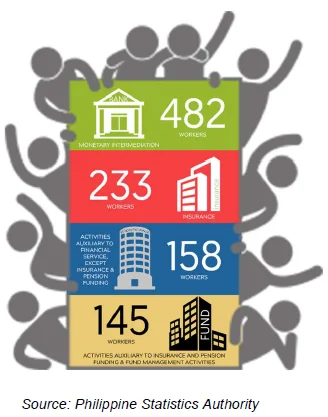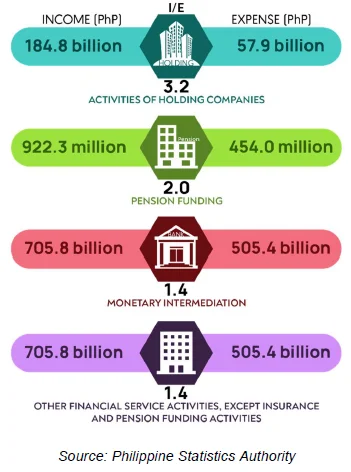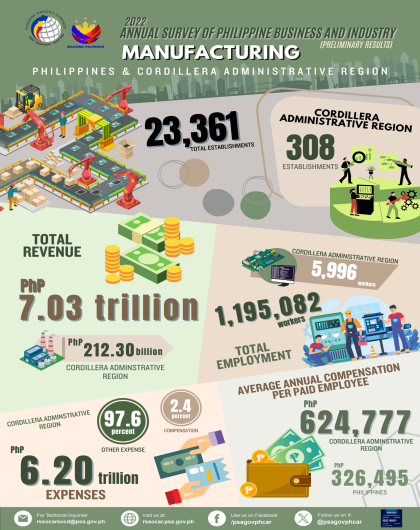Financial and insurance industry shrink by 2.3% in 2016
- Preliminary results of the 2016 Annual Survey of Philippine Business and Industry (ASPBI) showed that a total of 1,376 establishments with total employment (TE) of 20 and over in the formal sector of the economy were engaged in financial and insurance activities. This was 2.3% lower than the 1,408 recorded establishments in 2015. Consequently, workers engaged in financial and insurance activities declined by 9.5% from 360,997 in 2015 to 326,602 employees in 2016.
- Monetary Intermediation generated the most employment in the industry with more than 50% of the total national employment or 171,637 workers. Other Financial Service Activities, except Insurance and Pension Funding activities, was the second highest employer with 106,986 workers or 32.8% share. On the other hand, Pension Funding had the least contribution to national employment with a minimal 0.1% share.
Figure 1. Top Financial and Insurance Industries by Number of Establishments and
Total Employment: Philippines, 2016

- Two out of five (40.8%) financial and insurance establishments were located in the National Capital Region (NCR) while nearby regions CALABARZON and Central Luzon had 11.0% and 8.6% shares, respectively.
- Cordillera Administrative Region had a minimal 1.2% share of the total financial and insurance establishments, following ARMM with the least share of the number of establishments at 0.5%.
Figure 2. Top Financial and Insurance Industries by Average Employment per
Establishment, Philippines: 2016

- Monetary Intermediation sector hired the biggest number of employees with an average employment of 482 workers per establishment. This was followed by Insurance sector and sector involving Activities Auxiliary to Financial Service, except Insurance and Pension Funding acquiring services, with averages of 233 and 158 workers per establishment, respectively.
-
MIMAROPA had the highest mean employment per financial and insurance establishment at 451, closely followed by NCR with 411 employees. CAR financial and insurance businesses were manned by 76 workers on the average.
Compensation expenses of financial and insurance sector up by 22.1%
- The Financial and Insurance sector spent a total of PhP 204.1 billion to compensate its 326,095 paid employees in 2016. This was a 22.1% increase from the PhP 167.1 billion worth of compensation expended to 360,253 paid employees engaged in financial activities in 2015.
- Firms engaged with Monetary Intermediation remained to be the top employer in the financial and insurance sector spending PhP 131.9 billion for the compensation of its 171,637 paid workers. This was followed by establishments involved with Other Financial Service activities, except Insurance and Pension Funding activities with PhP 28.0 billion compensation and Insurance with PhP 21.3 billion.
-
Establishments in CAR disbursed a total of PhP 276.0 million to their financial and insurance employees in 2016. This led to an average annual compensation of PhP 214,670 per employee. Financial firms in NCR spent the highest for the compensation of its paid workers with PhP 182.5 billion.
Income of financial and insurance activities exceed expenses by more than 4 billion
Figure 3. Top Financial and Insurance Industries by Income per Expense, Annual
Income and Expense, Philippines: 2016

- Financial and Insurance industries generated a total income of PhP 1.5 trillion in 2016, reflecting a 27.7% increase from the previous year’s PhP 1.1 trillion income in 2015.
-
More than 90% or PhP 1.3 trillion of the total national income were from NCR financial establishments. Entities from Central Visayas generated the second highest income in the country with PhP 50.8 billion, followed by CALABARZON with PhP 16.2 billion and Davao Region with PhP 8.4 billion.
-
Monetary Intermediation sector contributed the highest income to the total national income with 48.2% share or PhP 705.8 billion. Income from Insurance companies came next with PhP 256.2 billion (17.5%) and activities of Holding Companies with PhP 184.8 billion (12.6%).
-
Expenditures of financial and insurance entities reached PhP 984.8 billion in 2016, a 20.9% increase from last year’s expenses of PhP 814.3 billion. The amount spent for the compensation of employees only made up 20.7% of the sector’s total spending.
- The two sub-sector top income-earners in financial and insurance activities were also the main contributors to the industry’s expenses: Monetary Intermediation establishments spent PhP 505.4 billion (51.3%) and Insurance companies with PhP 200.3 billion (20.3%).
-
Businesses situated in NCR (PhP 919.2 billion or 93.3%), Central Visayas (PhP 14.3 billion or 1.4%), and CALABARZON (PhP 12.9 billion or 1.3%) were the top spenders in 2016.
-
Activities of Holding Companies earned the greatest gain with an income per expense ratio of 3.2. This was followed by Trusts, Funds and Other Financial Vehicles and Pension Funding with 2.0 income per expense, respectively.
-
On the other hand, activities auxiliary to financial service, except Insurance and Pension Funding incurred the least income per expense ratio of 1.2 in 2016. This was followed by activities auxiliary to insurance and pension funding and Fund Management activities and Insurance, both having 1.3 income per expense.
-
Among all regions, only Central Visayas had an income per expense rate (3.5) higher than the national rate (1.5). NCR, Bicol, and Negros Island regions’ income per expense were at par with the country’s rate. CAR establishments recorded an income per expense ratio of 1.3, lower than the national figure.
Value added reaches PhP 860.4 billion
- Value added realized by financial and insurance activities in 2016 was PhP 860.4 billion. This figure increased by more than 50% relative to the previous year’s value (PhP 568.0 billion).
-
Industry-wise, Monetary Intermediation registered the highest value added with PhP 420.9 billion (48.9%). This was followed by activities of holding companies with PhP 163.1 billion (19.0%) and other financial service activities, except Insurance and Pension Funding activities with PhP 108.1 billion (12.6%). Meanwhile, Pension Funding had the least value added of PhP 476.3 million or about 0.1% of the total national rate.
-
Among regions, NCR (PhP 778.6 billion), Central Visayas (PhP 43.5 billion), and CALABARZON (PhP 9.5 billion) produced the most value added in 2016. CAR establishments reported PhP 723.1 million.
Subsidies decline by 72.0%
- The total subsidies received by the financial and insurance sector amounted to PhP 6.7 billion in 2016. This was 72.0% lower than the PhP 24.1 billion worth of subsidies granted by the government in 2015.
-
Only Monetary Intermediation and Other Financial Service activities, except Insurance and Pension funding activities industries received subsidies from the government with PhP 5.9 billion and PhP 814.0 million, respectively.
-
Across regions, NCR (PhP 6.7 billion), Ilocos Region (PhP 918 thousand), Central Luzon (PhP 11.0 million), and Zamboanga Peninsula (PhP 4.2 million) were the only recipients of subsidies from the government.
Figure 4. Subsidies Granted by the Government to Financial and Insurance Industries
and Regions, Philippines: 2016


